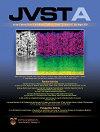利用分子氧和SF6/H2等离子体连续暴露超导氮化钛薄膜的各向同性等离子体-热原子层刻蚀
IF 2.1
3区 材料科学
Q3 MATERIALS SCIENCE, COATINGS & FILMS
引用次数: 1
摘要
超导TiN薄膜中的微波损耗是由氧化和微加工引起的损伤引起的不同界面的双能级系统造成的。原子层刻蚀(ALE)是一种新兴的刻蚀制造方法,它可以实现埃级刻蚀深度控制和潜在的小损伤。然而,虽然已经报道了用于TiN的ALE工艺,但它们要么使用HF蒸气,导致实际并发症,要么缺乏所需的蚀刻速率控制。此外,刻蚀膜的超导特性还没有被表征。在这里,我们报告了一个各向同性等离子体-热TiN ALE过程,包括连续暴露于分子氧和SF6/H2等离子体。在一定比例的SF6:H2流速下,我们观察到TiO2在TiN上的选择性蚀刻,在一个循环内实现了自我限制蚀刻。使用非原位椭偏仪测量蚀刻速率从150°C时的1.1 Å/cycle到350°C时的3.2 Å/cycle不等。我们证明了蚀刻膜的超导临界温度的降低不会超过从膜厚度的减少所期望的,突出了该工艺的低损伤性质。这些发现对于TiN在微波动力学电感探测器和超导量子比特中的应用具有重要意义。本文章由计算机程序翻译,如有差异,请以英文原文为准。
Isotropic plasma-thermal atomic layer etching of superconducting titanium nitride films using sequential exposures of molecular oxygen and SF6/H2 plasma
Microwave loss in superconducting TiN films is attributed to two-level systems in various interfaces arising in part from oxidation and microfabrication-induced damage. Atomic layer etching (ALE) is an emerging subtractive fabrication method which is capable of etching with angstrom-scale etch depth control and potentially less damage. However, while ALE processes for TiN have been reported, they either employ HF vapor, incurring practical complications, or the etch rate lacks the desired control. Furthermore, the superconducting characteristics of the etched films have not been characterized. Here, we report an isotropic plasma-thermal TiN ALE process consisting of sequential exposures to molecular oxygen and an SF6/H2 plasma. For certain ratios of SF6:H2 flow rates, we observe selective etching of TiO2 over TiN, enabling self-limiting etching within a cycle. Etch rates were measured to vary from 1.1 Å/cycle at 150°C to 3.2 Å/cycle at 350°C using ex situ ellipsometry. We demonstrate that the superconducting critical temperature of the etched film does not decrease beyond that expected from the decrease in film thickness, highlighting the low-damage nature of the process. These findings have relevance for applications of TiN in microwave kinetic inductance detectors and superconducting qubits.
求助全文
通过发布文献求助,成功后即可免费获取论文全文。
去求助
来源期刊

Journal of Vacuum Science & Technology A
工程技术-材料科学:膜
CiteScore
5.10
自引率
10.30%
发文量
247
审稿时长
2.1 months
期刊介绍:
Journal of Vacuum Science & Technology A publishes reports of original research, letters, and review articles that focus on fundamental scientific understanding of interfaces, surfaces, plasmas and thin films and on using this understanding to advance the state-of-the-art in various technological applications.
 求助内容:
求助内容: 应助结果提醒方式:
应助结果提醒方式:


